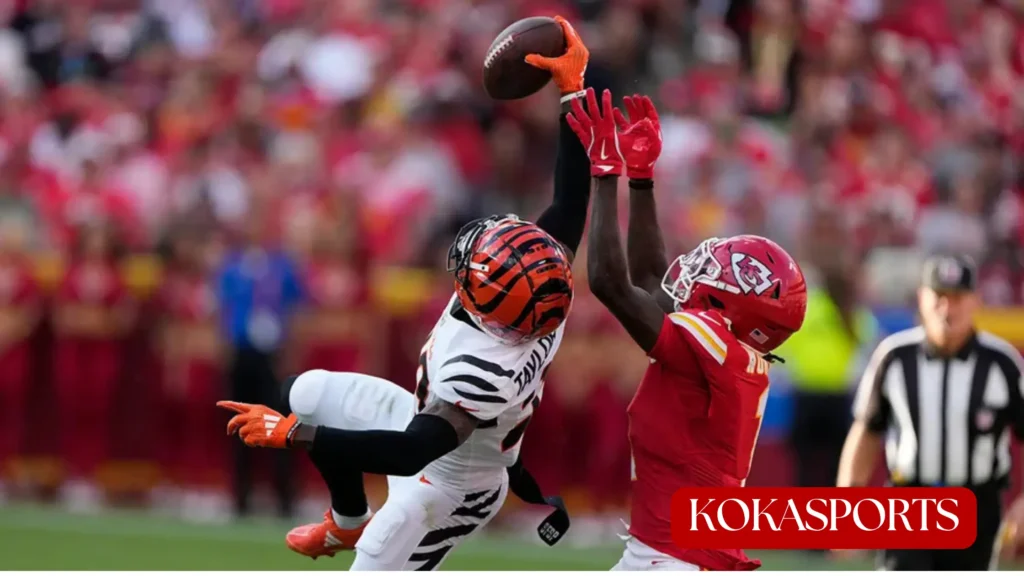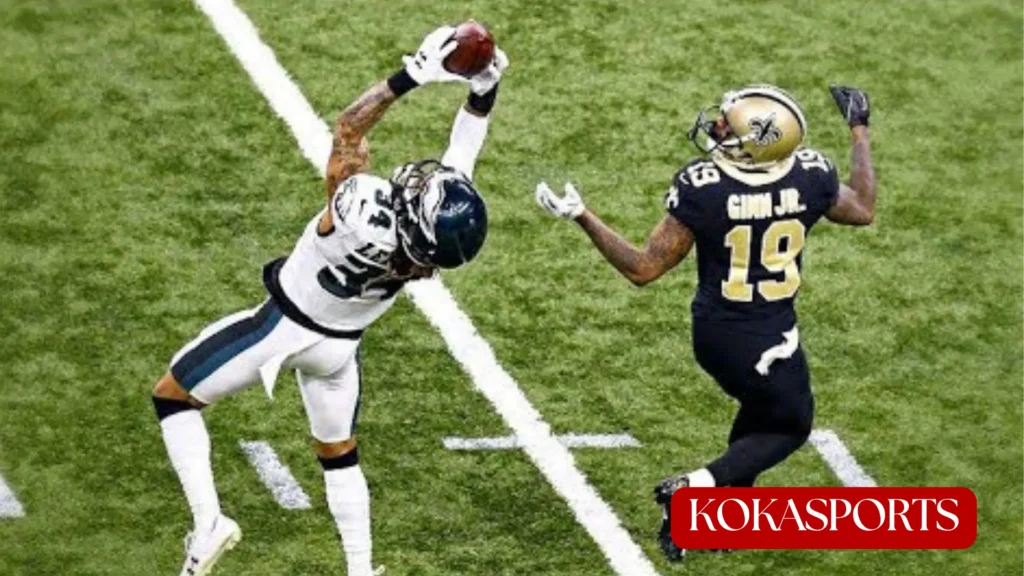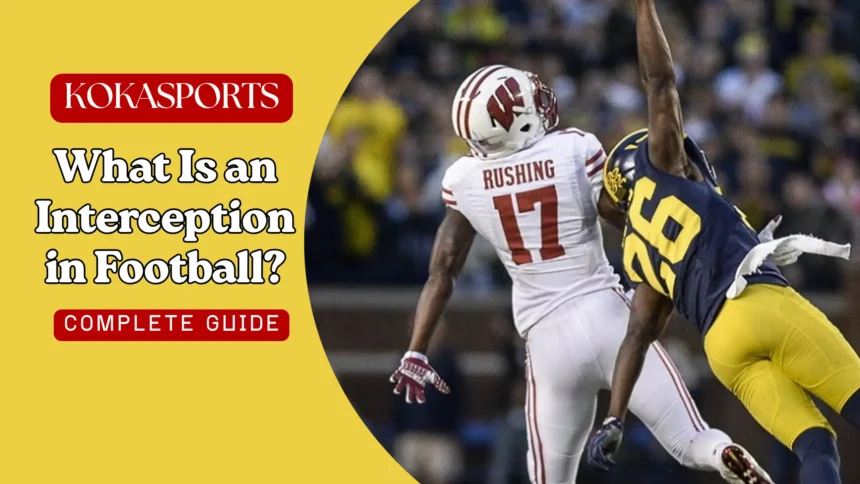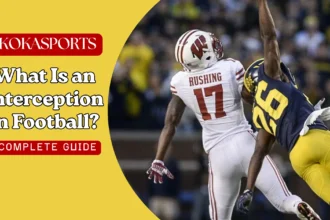An interception in football happens when a defensive player catches a pass thrown by the opposing team’s quarterback before it reaches the intended offensive receiver. This moment instantly shifts momentum and possession of the ball from one team to another, making it one of the most thrilling plays in American football.
Interceptions are game-changing moments that can turn a losing situation into a winning opportunity within seconds. When Ed Reed flew across the field to snatch a poorly thrown ball, or when Malcolm Butler secured his legendary Super Bowl catch, these plays became forever etched in NFL history. These moments don’t just change the scoreboard they change everything about how a game unfolds.
Throughout this guide, we’ll explore every aspect of interceptions, from how they happen to why they matter so much in today’s game. Whether you’re new to the sport or a seasoned football fan, this deep dive will give you fresh insight into one of the most exciting plays in sports.
What Is an Interception in Football? (Basic Definition and Meaning)

An interception occurs when a defensive player catches a forward pass that was meant for an offensive player on the opposing team. The moment the defender secures the catch, their team immediately gains possession and becomes the offensive team.
Think of it this way: when a quarterback throws the ball down the field, they’re trying to complete a pass to their teammate. But if someone from the defensive team steps in front and catches that ball instead, that’s an interception. The play doesn’t stop there the player who made the interception can now run with the ball, trying to advance the ball toward the other team’s end zone.
This differs significantly from a fumble, which happens when a player loses control of the ball while running or being tackled. A fumble can be recovered by anyone on the field, while an interception specifically involves catching a thrown ball before it hits the ground. Both are turnovers, but they happen in completely different ways.
The role of the defense in creating interceptions cannot be overstated. Every snap, defensive players study the offense’s formation, watch the quarterback’s eyes, and position themselves to break up or intercept a pass. This constant chess match between offense and defense makes football endlessly fascinating.
Here’s a quick example: imagine a quarterback drops back to throw on third down. A cornerback reads the play perfectly, breaks toward the receiver’s route, and leaps to snag the ball out of the air. The crowd erupts. The momentum completely shifts. That’s the power of an interception.
How an Interception Happens in Football
The Process of an Interception – Step by Step
The process begins with the quarterback scanning the field for an open receiver. Meanwhile, defensive backs and linebackers watch the QB’s eyes, shoulders, and arm motion to predict where the pass will go. When the quarterback releases the ball, defenders must react instantly.
A successful interception occurs when the defensive player:
- Reads the play correctly by studying film and recognizing offensive patterns
- Positions themselves between the ball and the intended receiver
- Times their jump or break perfectly to reach the ball first
- Secures the catch with proper hand placement and focus
- Maintains possession while potentially absorbing contact from blockers
Common quarterback mistakes that lead to interceptions include staring down receivers, throwing off their back foot, forcing passes into tight coverage, and misjudging the speed of defensive players. Even elite quarterbacks make these errors under pressure, which is why studying game film and making quick decisions are crucial skills.
Defenders anticipate routes by recognizing formation tendencies. If a team runs a particular route combination on third-and-seven, smart defenders remember that tendency and jump the route the next time they see the same setup. This mental aspect of the game separates good defenders from great ones.
The Importance of the Ball and Positioning
Ball tracking separates average defensive backs from elite ones. The ability to locate the ball while maintaining position on the receiver requires incredible spatial awareness and practice. Defenders must run at full speed, turn their heads at precisely the right moment, and adjust their body to make a play on the ball.
Cornerbacks typically defend the outside receivers and use their speed and agility to stay step-for-step with fast receivers. They’re often the first line of defense and need quick reactions. Safeties play deeper and have more time to read plays, allowing them to intercept passes thrown down the middle of the field. Their interception opportunities often come from reading the quarterback’s progression and breaking on balls thrown over the middle.
Linebackers contribute to interceptions by dropping into pass coverage and patrolling the short-to-intermediate zones. When quarterbacks try to hit quick slants or crossing routes, linebackers can step in front and make plays. Their size advantage over running backs and tight ends makes them dangerous when they get their hands on the ball.
Key Players and Positions Involved in an Interception in Football

Defensive Backs (Cornerbacks and Safeties)
Cornerbacks and safeties are specialists at intercepting passes because they spend every play covering receivers and watching the quarterback. These defensive specialists combine athletic ability with football intelligence to create turnover opportunities.
Read More: What Is a Rip Move in Football? Complete Guide to the Rip Technique & Drills
Famous NFL Players Known for Interceptions:
| Player | Position | Career Interceptions | Notable Achievement |
|---|---|---|---|
| Paul Krause | Safety | 81 | All-time leader |
| Ed Reed | Safety | 64 | Record 1,590 return yards |
| Deion Sanders | Cornerback | 53 | 9 touchdown returns |
| Night Train Dick Lane | Cornerback | 68 | 14 picks in rookie season |
Ed Reed revolutionized the safety position with his ball-hawking ability and return skills. His instincts allowed him to read quarterbacks like few others could. Deion Sanders combined elite coverage skills with blazing speed, making him dangerous both in preventing completions and taking interceptions back for scores.
Linebackers and Their Role in Interceptions
Linebackers make their living in the middle of the field, where they must balance run defense with pass coverage responsibilities. Modern football asks linebackers to be versatile athletes who can drop into coverage and make plays on the ball.
These players succeed by watching the quarterback’s eyes during their drop-back. When a QB looks toward a receiver, smart linebackers break toward that area, ready to jump routes. The best linebackers study offensive tendencies so thoroughly that they can predict plays before they develop.
The Quarterback’s Perspective
Quarterbacks work tirelessly to avoid throwing interceptions. They study defensive coverages, learn to manipulate safeties with their eyes, and develop touch to place balls where only their receivers can catch them. Despite these efforts, every quarterback throws interceptions it’s part of the game.
Common mistakes include:
- Forcing throws into double coverage when under pressure
- Telegraphing passes by staring down primary receivers
- Underthrowing deep balls that allow safeties to close distance
- Throwing late on timing routes, giving defenders time to break
- Poor footwork leading to inaccurate throws that float toward defenders
Difference Between an Interception and a Fumble in Football
While both are turnovers, interceptions and fumbles happen differently. An interception involves catching a thrown ball, while a fumble occurs when a player loses control of the ball while running or being tackled. Both result in a change of possession, but the circumstances surrounding each differ dramatically.
Fumbles can happen to any player carrying the ball running backs, receivers after catches, or even quarterbacks scrambling. The ball hits the ground and becomes live, meaning either team can recover it. Interceptions specifically involve defensive players catching passes before they’re completed.
Coaches train players to prevent both through different methods. For fumbles, they emphasize ball security carrying the ball high and tight, covering it with both hands when contact is imminent. For interceptions, they focus on decision-making, reading defenses, and throwing with proper timing and accuracy.
Game impact varies by situation. A fumble deep in your own territory can be devastating, giving the opposing team excellent field position. An interception on a critical third down can be equally costly, ending a promising drive and shifting momentum. Both can be returned for a touchdown, though interceptions more commonly result in long returns since defensive backs typically have more open field.
What Happens After an Interception in Football?
Change of Possession
The instant a defensive player secures an interception, their team becomes the offense and can advance the ball upfield. Unlike an incomplete pass where play stops, an interception creates a live-ball situation where the intercepting team tries to gain as many yards as possible.
Play continues until the player who caught the interception is tackled, runs out of bounds, or scores a touchdown. Teammates immediately switch to blocking mode, trying to clear paths and throw blocks to help their teammate gain maximum yardage. This sudden role reversal makes interceptions so exciting defensive players become ball carriers, and offensive players become desperate tacklers.
Pick Six – Turning Defense Into Points
A pick six (also called a pick 6) happens when an interception is returned for a touchdown the defender catches the ball and runs it all the way into the end zone for a touchdown, earning 6 points (or six points) for their team. These plays rank among the most electrifying moments in sports.
Why are pick sixes so impactful? They represent a 14-point swing in potential scoring. Not only does the offensive team lose their opportunity to score, but the defending team immediately puts points on the board. This dramatic shift can demoralize an offense and energize an entire stadium.
Famous Pick Sixes in NFL History:
- Tracy Porter’s interception against Peyton Manning in Super Bowl XLIV sealed the Washington Redskins’ victory (though Porter played for New Orleans)
- Malcolm Butler’s goal-line interception in Super Bowl XLIX saved the Patriots’ championship
- James Harrison’s 100-yard return in Super Bowl XLIII remains the longest touchdown in Super Bowl history
The Role of Coaches After an Interception
Coach strategies shift immediately after turnovers. Offensive coaches who just lost possession often call conservative plays to prevent further mistakes. Defensive coaches who created the turnover might call aggressive plays to capitalize on momentum, or they might play conservatively to protect the lead.
Defensive coaches train players to practice “fast break” situations scenarios where they practice what to do immediately after creating turnovers. They emphasize securing the ball first, then looking for blocking and running lanes. The best defensive coordinators drill these situations repeatedly because turnovers happen unexpectedly, and players must react instinctively.
How Interceptions Impact Football Strategy and Game Flow

Momentum Shifts and Game-Changing Moments
Interceptions completely alter game momentum. A team driving confidently down the field suddenly watches helplessly as their opponent celebrates. The crowd noise shifts from one side to the other. Players’ body language changes instantly.
Games are regularly decided by single interceptions. Consider a close game in the fourth quarter where a team is driving for the winning score. An interception ends that drive and gives the opponent a chance to run out the clock. That one play determines the winner.
Statistical analysis shows teams that win the turnover battle win approximately 75% of games. This correlation explains why coaches obsess over protecting the ball on offense and creating turnovers on defense. Every interception dramatically shifts win probability.
Coaching and Training Focus on Interceptions
Coaches dedicate significant practice time to interception prevention and creation. Quarterbacks work on reading coverages pre-snap to avoid throwing into dangerous situations. They practice throwing to spots rather than receivers, placing balls where only their targets can make plays.
Defensive players spend hours studying film, learning offensive tendencies and quarterback habits. They practice ball drills exercises focused on tracking the ball, timing jumps, and securing catches. They learn to play through receivers’ hands without committing penalties.
Modern teams use virtual reality and advanced analytics to improve their interception rates. Defenders can experience thousands of reps in VR, training their recognition skills without physical wear. Analytics help identify which quarterbacks are most likely to throw interceptions in specific situations.
Statistical Importance in the NFL and Football Leagues
Interceptions affect team rankings across multiple categories. Teams with high interception totals typically rank higher defensively and win more games. Individual players who lead the league in interceptions (abbreviated as INT in statistics) receive All-Pro honors and increase their contract value.
The modern NFL has seen interception rates decline as passing offenses become more sophisticated. Quarterbacks make better decisions, offensive schemes create more open receivers, and rules favor passing attacks. Despite this trend, elite defensive backs still find ways to create turnovers through superior technique and instincts.
Famous Interceptions in NFL History
Legendary Plays That Changed the Game
Malcolm Butler’s Super Bowl XLIX interception stands as one of the most dramatic plays in championship history. With Seattle threatening to score and win, Butler recognized the play, fought through traffic, and catches a pass intended for an offensive receiver at the goal line. His heads-up play secured a championship.
Tracy Porter’s pick six against Peyton Manning in Super Bowl XLIV demonstrated the importance of film study. Porter recognized the route combination, jumped the pass, and raced 74 yards for the clinching touchdown. His preparation paid off on football’s biggest stage.
Ed Reed’s career featured countless spectacular interceptions, but his ability to return them for touchdowns set him apart. He holds the record for interception return yards and revolutionized how safeties play the position. His instincts and return ability made him arguably the greatest ball-hawking safety ever.
Top NFL Players Known for Interceptions
Paul Krause’s record of 81 career interceptions has stood since 1979. His consistency and longevity at the safety position created a standard that future players still chase. Krause averaged nearly six interceptions per season across his 16-year career.
Current stars continue the tradition. Defensive backs like Trevon Diggs and Xavien Howard regularly lead the NFL in interceptions, combining modern technique with classic ball skills. Their success proves that despite evolution in passing attacks, great defenders can still create turnovers.
Records and Milestones in Interception History
Record-Breaking Performances:
- Most interceptions in a single season: Night Train Dick Lane (14 in 1952)
- Most career interceptions: Paul Krause (81)
- Most interception return yards: Ed Reed (1,590)
- Longest interception return: Ed Reed and several others (108 yards, including end zone depth)
These records showcase sustained excellence and big-play ability. Modern rule changes make some records harder to break, but they remain benchmarks for defensive greatness.
Tips for Players and Coaches on Preventing or Creating Interceptions in Football
For Defensive Players – How to Intercept the Ball
Successful defenders master these skills:
- Read quarterback’s eyes to anticipate throw direction
- Study film religiously to recognize offensive patterns and tendencies
- Improve hand-eye coordination through daily catch drills
- Practice breaking on the ball at different angles and speeds
- Develop route recognition to jump passes before they arrive
- Maintain proper leverage on receivers while tracking the ball
- Finish plays by securing catches and protecting the ball after contact
Top cornerbacks spend extra time after practice working on these fundamentals. They know that small improvements in reaction time or ball tracking can mean the difference between a pass breakup and an interception.
For Offensive Players – How to Avoid Getting Intercepted
Quarterbacks protect the ball by:
- Going through full progressions instead of locking onto primary receivers
- Throwing balls away when no receivers are open
- Using pump fakes to manipulate defensive positioning
- Recognizing disguised coverages before the snap
- Developing chemistry with receivers on timing routes
Receivers help prevent interceptions by running crisp routes, fighting back to underthrown balls, and never giving up on plays. Communication between quarterback and receiver ensures both players read defenses identically, preventing miscommunications that lead to picks.
Coach Strategies for Minimizing Turnovers
Successful coaches implement comprehensive turnover prevention programs. They track turnover ratios religiously, reward ball security in film sessions, and create competitive practice situations that simulate game pressure. Teams that defend the ball win championships.
Training drills used across football include:
- Ball security circuits where ball carriers navigate through attempted strips
- Recognition drills where quarterbacks identify coverages quickly
- Seven-on-seven passing that emphasizes decision-making without pass rush
- Situational practice replicating high-pressure game scenarios
Interceptions in Different Levels of Football and Leagues
NFL vs. College Football vs. High School
Interception rates vary significantly across football levels. High school games typically see more interceptions due to less-developed quarterback play and simpler defensive schemes. College football falls somewhere in the middle, with more sophisticated offenses than high school but less refined than professional.
The NFL features the lowest interception rates because quarterbacks make better decisions and defenses face restrictions on contact. Rules at each level differ slightly, but the fundamental concept remains the same catching a pass thrown by the opposing team’s quarterback creates a turnover.
Player skill development progresses through each level. High school players learn basic techniques, college players refine those skills while learning complex schemes, and NFL players perfect their craft against the world’s best competition.
Interception Stats in Modern NFL Leagues
Recent trends show declining interception rates across the NFL. In the 1980s, teams averaged about 1.2 interceptions per game. Today, that number has dropped to roughly 0.75 per game. This decline reflects better quarterback play, rule changes favoring passing, and more sophisticated offensive schemes.
The evolution of passing offenses impacts interception rates significantly. Modern offenses use shorter, quicker passes that give defenders less time to react. Quarterbacks read defenses better pre-snap, avoiding obvious coverage traps. Despite these challenges, elite defenders continue finding ways to create turnovers.
Conclusion:
Interceptions represent everything exciting about football athleticism, strategy, momentum shifts, and game-changing plays that happen in an instant. These defensive masterpieces showcase the chess match between quarterbacks and defenders, where preparation meets opportunity at exactly the right moment.
Defense wins championships, and creating turnovers sits at the heart of successful defensive play. Whether it’s a cornerback reading routes perfectly, a safety breaking on a deep ball, or a linebacker stepping in front of a crossing route, interceptions embody the aggressive, opportunistic mentality that defines great defenses.
For football fans who want to appreciate the game more deeply, watch how defenses disguise coverage, how defenders study quarterbacks pre-snap, and how one perfectly-timed break on the ball can change everything. These moments make the sport unpredictable and thrilling.
Keep watching NFL games with fresh eyes, paying attention to defensive positioning and quarterback decision-making. Each interception tells a story of preparation, execution, and the constant battle between offense and defense that makes football America’s most popular sport.
FAQs
How does an interception work in football?
A defender catches a pass meant for the offense, taking possession of the ball.
What’s the difference between a tackle and an interception?
A tackle stops a player; an interception steals a thrown pass.
Is a pick the same as an interception?
Yes, “pick” is slang for an interception, especially a pick six.
What’s the difference between an interception and a fumble?
An interception happens on a pass; a fumble occurs when a player drops the ball.
Who has the most interceptions in NFL history?
Paul Krause, with 81 career interceptions.



